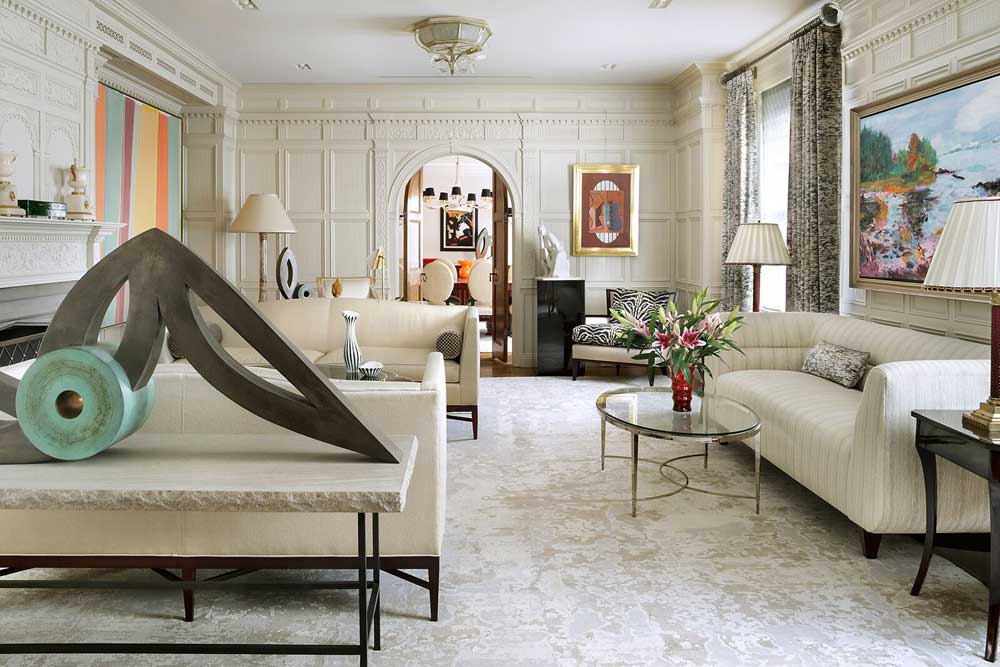Written by Leslie Garisto Pfaff
Design by Stephen E. Kowalski and Virginia Zonfrilli
Photography by Peter Rymwid
The apartment was a grande dame stubbornly stuck in another century, and it was clear to the owners—and to the architect and designer—that it would require meticulous coaxing to usher it into the present day. Its prewar pedigree was evidenced in high ceilings throughout and stunning hand-hewn millwork in the living room and library. But its lighting, cooling, heating and mechanical systems were woefully out of date, and to bring them up to code would require the installation of bulky ductwork that threatened to undermine the effect of all those graceful architectural details.
The owners—with an aesthetic vision honed by years of connoisseurship—understood that, in the right hands, the full-floor apartment awash in natural light could be transformed into a comfortable, elegant, contemporary home for the two of them, their three dogs, and their ample collection of paintings and sculptures. The professionals charged with that transformation—tktktk-based architect Stephen E. Kowalski and interior designer Virginia Zonfrilli of tktktktk—shared the owners’ vision but were well aware of the difficulties it posed.
“The greatest challenge,” says Kowalski, “was trying to fit all those ducts into places where there was no room for them, without it looking as if we’d deliberately built around them.” He and his team succeeded brilliantly. To hide a duct that ran along the foyer, for instance, they created a large, trimmed panel that fit in seamlessly with the space’s other architectural detailing.
Zonfrilli had challenges of her own. Thanks to a layout in which the living room and library were visible from the dining room, it was essential to create a sense of continuity throughout the apartment— despite the fact that each room has a slightly different aesthetic. “The dining room is transitional in style,” Zonfrilli explains, “while the living room is a mix of transitional and traditional, and the library is very contemporary.” To create a seamless sense of flow, she employed a neutral color scheme of taupe, ivory and gray, which was used in every room. In the living room, the original carved paneling and trim were painted in a single shade of ivory, echoed in the coffered ceiling created for the dining room and much of the apartment’s upholstery and window- and wallcoverings.
The subdued palette also highlights the artwork, which tends to be color-saturated. Zonfrilli was familiar with the owners’ collection, which she kept in mind throughout the design process—though, in fact, the placement of the art was a collaboration between designer and clients that took place at the very end of the renovation and yielded a few surprises. The only space that could accommodate the owners’ largest painting, for instance, happened to be the wall at the end of the foyer, a particularly dramatic area of the apartment thanks to a tiled barrel ceiling that mirrors the inlaid pattern on the stone floor. And yet, Zonfrilli notes, “once the painting was in place it looked as if the room had been built around it.”
Just off the foyer is the powder room, which the designer describes as “a little jewel box.” Fitted with crystal-beaded wallcovering and a sculptural carved-glass vessel sink atop a large fluted base, it turned out to be one of the owners’ and designer’s favorite spaces, perfectly at home in an apartment where art is an essential.
Not only were the clients’ pleased, the apartment’s design garnered a gold award from the New Jersey chapter of the American Society of Interior Designers. More important, it’s an aesthetically fitting home for these passionate collectors, as much a work of art as the pieces for which it’s a showcase.
